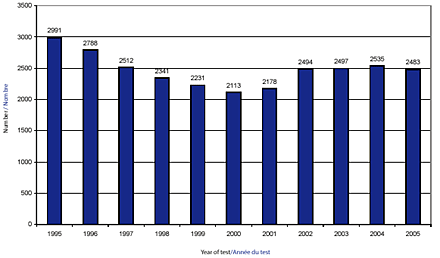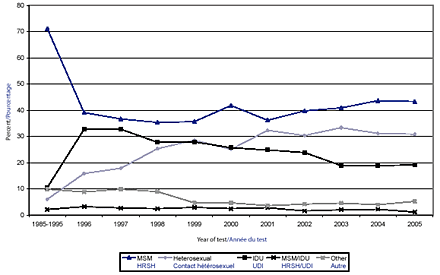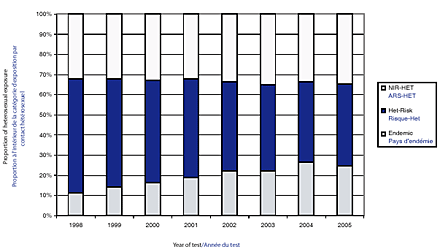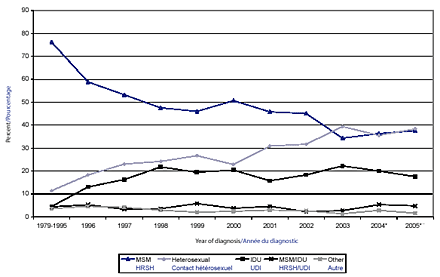Common menu bar links
Institutional links
Diseases & Conditions
Health & Safety
Research & Statistics
Agency Information
Search Box
E-mail this page
HIV and AIDS in Canada
Surveillance Report to December 31, 2005
April 2006
Surveillance and Risk Assessment
Division
Centre for Infectious Disease Prevention and Control
Public Health Agency of Canada
PDF Version 
97 Pages -
(2.4 MB)
Cat No.H121-1/2005-2 ISBN
0-662-49254-4
(On-line) Cat.No.H121-1/2005-2-PDF ISBN 0-662-49255-2
Information to the readers of HIV and AIDS in Canada
On behalf of the HIV/AIDS Surveillance Section, I would like to present you with the HIV and AIDS in Canada: Surveillance Report to December 31, 2005. This report is part of a semi-annual series providing a review of available HIV and AIDS surveillance data in Canada.
The HIV/AIDS Surveillance section is part of the Surveillance and Risk Assessment Division, at the Centre for Infectious Disease Prevention and Control. This section is responsible for data collection and management, analysis and report production. In addition, we continue to improve data quality, define and set surveillance standards, as well as support the use of these data to influence programmatic and policy action.
The main findings of the surveillance data are outlined in the section entitled At a Glance, and this is followed by a series of tables summarizing the underlying data. Technical notes in addition to references and data sources are available in the Appendices. Explanatory details specific to provincial or territorial surveillance data issues are located at the beginning of each section.
A further description of HIV and AIDS surveillance data is available in the HIV/AIDS Epi Updates reports that are also available on our Web site listed on the front cover of this report.
The publication of this report would not be possible without the submission of HIV and AIDS surveillance data from all provinces and territories. Their ongoing contribution to national HIV and AIDS surveillance is gratefully acknowledged and is further listed in Appendix 5.
Yours sincerely,
Jennifer Pennock, MSc
Acting Manager
HIV/AIDS Surveillance Section
Surveillance and Risk Assessment Division
Table of Contents |
|||
| At a Glance | |||
| TABLES | |||
| SECTION I HIV in Canada: Positive HIV test reports toDecember 31, 2005 and reported to CIDPCup to February 10, 2006 |
|||
| 1. | Number of positive HIV test reports by year of test (all ages) | ||
| 2. | Cumulative number of positive HIV test reports occurring in adults and children by gender between November 1, 1985, and December 31, 2005 | ||
| 3. | Number of positive HIV test reports among adults (≥ 15 years) by year of test and gender | ||
| 4A. | Number of positive HIV test reports by age group and year of test | ||
| 4B. | Number of positive HIV test reports among males by age group and year of test | ||
| 4C. | Number of positive HIV test reports among females by age group and year of test | ||
| 5A. | Number and percentage distribution of positive HIV test reports among adults (≥ 15 years) by exposure category and year of test | ||
| 5B. | Number and percentage distribution of positive HIV test reports among adult males (≥ 15 years) by exposure category and year of test | ||
| 5C. | Number and percentage distribution of positive HIV test reports among adult females (≥ 15 years) by exposure category and year of test | ||
| 5D. | Number and percentage distribution of positive HIV test reports among children (< 15 years) by exposure category and year of test | ||
| 5E. | Number of positive HIV test reports by exposure category and age group between January 1, 2005 and December 31, 2005 | ||
| 6A. | Number of positive HIV test reports by province/territory and gender between November 1, 1985, and December 31, 2005 (all ages) | ||
| 6B. | Number of positive HIV test reports by province/territory and year of test (all ages) | ||
| 7. | Number of positive HIV test reports by exposure category and province/territory between January 1, 2005, and December 31, 2005 (all ages) | ||
| 8. | Number of positive HIV test reports by year of test and ethnic status for those provinces/territories that submitted ethnicity data between 1998 and December 31, 2005 (all ages) | ||
| SECTION II Report of the Canadian Perinatal HIVSurveillance Program, 1984-2005 |
|||
| 9. | Number of Canadian perinatally HIV-exposed infants by maternal exposure and year of infant birth, 1984-2005 | ||
| 10. | Number of Canadian perinatally HIV-exposed infants by year of birth, current status and use of antiretroviral therapy (ART) for prophylaxis, 1984-2005 | ||
| 11. | Cumulative number of Canadian perinatally HIV-exposed infants by geographic region and status at last report, 1984-2005 | ||
| 12. | Cumulative number of Canadian perinatally HIV-exposed infants by ethnic status and current status, 1984-2005 | ||
| SECTION III AIDS in Canada: AIDS Surveillance to December 31, 2005 and Reported to CIDPC up to February 10, 2006 |
|||
| 13. | Number of reported AIDS cases by year of diagnosis (all ages) | ||
| 14. | Cumulative number of reported AIDS cases occurring in adults and children by gender between 1979 and December 31, 2005 | ||
| 15. | Number of reported AIDS cases among adults (≥ 15 years) by year of diagnosis and gender | ||
| 16A. | Number of reported AIDS cases by age group and year of diagnosis | ||
| 16B. | Number of reported AIDS cases among males by age group and year of diagnosis | ||
| 16C. | Number of reported AIDS cases among females by age group and year of diagnosis | ||
| 17A. | Number and percentage distribution of reported AIDS cases among adult (≥ 15 years) by exposure category and year of diagnosis | ||
| 17B. | Number and percentage distribution of reported AIDS cases among adult males (≥15 years) by exposure category and year of diagnosis | ||
| 17C. | Number and percentage distribution of reported AIDS cases among adult females (≥ 15 years) by exposure category and year of diagnosis | ||
| 17D. | Number and percentage distribution of reported AIDS cases among children (< 15 years) by exposure category and year of diagnosis | ||
| 17E. | Number of reported AIDS cases among adults (≥ 15 years) by exposure category and age group between 1979 and December 31, 2005 | ||
| 17F. | Number of reported AIDS cases among children (< 15 years) by exposure category and age group between 1979 and December 31, 2005 | ||
| 18A. | Number of reported AIDS cases by province/ territory and gender between 1979 and December 31, 2005 (all ages) | ||
| 18B. | Number of reported AIDS cases by province/ territory and year of diagnosis (all ages) | ||
| 18C. | Number of reported AIDS cases among males by province/territory and year of diagnosis (all ages) | ||
| 18D. | Number of reported AIDS cases among females by province/territory and year of diagnosis (all ages) | ||
| 19. | Number and percentage distribution of reported AIDS cases by province/territory and exposure category to December 31, 2005 (all ages) | ||
| 20. | Number of reported AIDS cases by year of diagnosis and ethnic status (all ages) | ||
| SECTION IV a. Mortality due to HIV/AIDS in Canada:Surveillance to December 31, 2005,and Reported to CIDPC up to February 10, 2006 |
|||
| 21. | Reported deaths among reported AIDS cases by year of death (all ages) | ||
| 22. | Cumulative number of reported deaths among reported AIDS cases occurring in adults and children by age of death and gender between 1979 and December 31, 2005 | ||
| 23. | Reported deaths among reported AIDS cases among adults (≥ 15 years) and children by year of death | ||
| 24. | Reported deaths among reported AIDS cases among adults (≥ 15 years) by year of death and gender | ||
| 25A. | Reported deaths among reported AIDS cases and percentage distribution of adults (≥ 15 years) by exposure category and year of death | ||
| 25B. | Reported deaths among reported AIDS cases and percentage distribution of adult males (≥ 15 years) by exposure category and year of death | ||
| 25C. | Reported deaths among reported AIDS cases and percentage distribution of adult females (≥ 15 years) by exposure category and year of death | ||
| b. Mortality due to HIV/AIDS in Canada:Vital Statistics from 1987 to December 31, 2003 | |||
| 21S. | Deaths attributed to HIV infection by year of death (all ages) | ||
| 22S. | Number of deaths attributed to HIV infection by age of death and gender from 1987 to December 31, 2003 | ||
| 23S. | Deaths attributed to HIV infection among adults (≥ 15 years) and children by year of death | ||
| 24S. | Deaths attributed to HIV infection among adults (≥ 15 years) by year of death and gender | ||
| SECTION V International Statistics on AIDS |
|||
| APPENDICES | |||
| Appendix 1. Technical Notes | |||
| Appendix 2. Data Limitations | |||
| Appendix 3. Terminology | |||
| Appendix 4. References | |||
| Appendix 5. Data Sources | |||
At a Glance
Introduction
The following report outlines HIV and AIDS surveillance data providing a description of persons who have been diagnosed with HIV and AIDS in Canada. Surveillance data understate the magnitude of the HIV epidemic and consequently do not represent the number of people infected with HIV (prevalence) or the number infected each year (incidence). Some of the reasons for this include the fact that surveillance data are subject to delays in reporting, underreporting and changing patterns in HIV testing behaviours (who comes forward for testing). In addition, surveillance data can only tell us about persons who have been tested and diagnosed with HIV or AIDS and not those who remain untested and undiagnosed. Furthermore, because HIV is a chronic infection with a long latent period, many persons who are newly infected in a given year may not be diagnosed until later years.
HIV Surveillance
A total of 60,160 positive HIV tests have been reported to the Public Health Agency of Canada (PHAC) from November 1985 (when reporting began) up to December 31, 2005. Figure 1 presents the trend in positive HIV test reports for the last decade (from 1995 to 2005). The absolute number of positive HIV tests reported to PHAC began to decrease in 1995 from 2,991 to 2,113 in the year 2000. The number of positive HIV test reports then increased to 2,494 reported in 2002. Since then, the number of positive HIV test reports has remained at approximately 2,500 each year.
Surveillance data for 2005 demonstrate the persistence of trends among women that have been documented in previous surveillance reports1,2. Women continue to account for one quarter of positive HIV test reports (25.4% in 2005), an increase from pre-1996, when they accounted for just over ten per cent of tests (10.6%). Women also account for a substantial proportion of positive HIV test reports in the 15 to 29 year age group. In 2005, they accounted for 35% of tests in this age group, which is an increase from 14.1% for the 1985 to 1995 period.
| FIGURE 1 Positive HIV test reports by year of test, 1995-2005 |
 |
Although men who have sex with men (MSM) account for the largest proportion of positive HIV test reports (43.5% in 2005), the heterosexual exposure category continues to account for a significant number and proportion of positive HIV test reports (Figure 2). In 2005, this diverse exposure category accounted for just under a third (30.9%) of positive HIV test reports, a trend observed since 2001. Figure 3 breaks the heterosexual exposure category down according to its three subcategories: HIV-Endemic (a person born in a country where HIV is endemic), Het-Risk (heterosexual contact with a person who is either HIV-infected or at increased risk for HIV), and NIR-Het (heterosexual contact as the only identified risk). When examined over time, it can be seen that the HIV-endemic exposure sub-category has accounted for an increasing proportion of heterosexual positive HIV test reports from 11.5% of test reports in 1998 to almost a quarter (24.8%) in 2005*. Although the proportion of Het-Risk has accounted for a decreasing proportion of positive HIV test reports within the heterosexual exposure category, the proportion attributed to NIR-Het has remained fairly constant over time, at about one third of tests. Combined, the Het-Risk and NIR-Het subcategories account for the greatest proportion of test reports within the entire heterosexual exposure category, and these reports have limited information on the characteristics of partners or other potential risk behaviours. The lack of these data makes it difficult to monitor the heterosexual component of the epidemic.
| FIGURE 2 Positive HIV test reports by exposure category and year of test |
 |
| FIGURE 3 Positive HIV test reports among heterosexual transmission by sub category, 1998-2005 |
 |
Immigration
Changes to policies at Citizenship and Immigration Canada (CIC)† can likely explain some of the increase in the number of positive HIV test reports in the last four years. On January 15, 2002, CIC added routine HIV screening for all applicants who require an Immigration Medical Examination (IME) and are 15 years and over, as well as on those children who have received blood or blood products, have a known HIV-positive mother or are potential adoptees. In 2004, CIC discontinued the routine HIV testing of potential adoptees.
In June 2002, the Immigration and Refugee Protection
Act (IRPA) was implemented requiring that applicants be
assessed for the health grounds of inadmissibility (danger to
public health, danger to public safety and excessive demands on
health or social services). However, the Act exempted certain
groups of immigrants from excessive demand evaluation. Information
on this legislation is available on the CIC website (www.cic.gc.ca). 
Between January 15, 2002 and December 31, 2005, about two thousand applicants who underwent an IME tested positive for HIV‡. In 2005, about 668 applicants who underwent an IME tested HIV-positive. Of these, 389 were identified by HIV testing in Canada, and 279 were identified outside of Canada.
IME HIV testing undertaken in Canada is managed and reported in the same manner as all other positive HIV tests diagnosed among Canadians, and are included in provincial/territorial HIV reporting to PHAC. In September 2004, CIC introduced reporting to provincial/territorial health authorities of HIV cases, medically examined overseas, who have entered Canada.
Of the 668 HIV-positive diagnoses in 2005, 432 (64.7%) were born in Africa and the Middle East, 155 (23.2%) in the Americas, 57 (8.5%) in Asia and 24 (3.6%) in Europe. In 2005, the 389 HIV-positive tests identified in Canada represent 15.7% (389/2,483) of the positive HIV tests reported to PHAC.
Canadian Perinatal HIV Surveillance Program
The Canadian Perinatal HIV Surveillance Program is an active surveillance of all identified infants and children born to HIV infected mothers. The program includes infants exposed to antiretroviral therapy during pregnancy and older infants and children not identified in the perinatal period. There have been 2,206 infants identified as perinatally exposed to HIV born between 1984 and 2005 in Canada. The number of HIV-exposed infants reported per birth-year has increased steadily from 87 infants in 1993 to 173 in 2005. The overall proportion of HIV-exposed infants whose mothers' HIV status was attributed to the exposure category of heterosexual contact was 70.7%, and 27.5% were attributed to injecting drug use.
Although the number of HIV-exposed infants has increased for each birth-year, the proportion of infants confirmed to be HIV infected has decreased from 39.5% in 1994 to 4% in 2005. Correspondingly, the proportion of HIV-positive mothers receiving antiretroviral therapy has increased steadily reaching a high of 89% in 2005 (Section II).
AIDS Surveillance
It is important to note the limitations associated with AIDS diagnoses reported for the year 2005. AIDS data have not been available from the province of Quebec since June 30, 2003, so the counts reported in this surveillance report are not representative of the true number of AIDS diagnoses in Canada. Furthermore, the province of Ontario undertook an IT-application change for AIDS case management and reporting in 2005. As part of this conversion, AIDS diagnoses reported in the second half of 2005 did not contain any exposure category or ethnicity data. Caution must be used when interpreting trends over time both nationally and at the provincial level. Further details regarding these data limitations are available in Section III. Moreover, a description of AIDS diagnoses adjusted for reporting delay was not available at the time of printing.
The change in the availability and quality of AIDS data in Canada comes at a time when HIV/AIDS stakeholders such as the World Health Organization (WHO) and the Centres for Disease Control (CDC) in the United States are examining staging of HIV/ AIDS and case definitions. Both processes include a revision to staging for HIV/AIDS that includes a clinical and immunologic component (CD4 count). They also include a revision to the AIDS case definition for the purpose of surveillance. Increasingly, HIV and its progression to AIDS is being viewed as a continuum with salient points that should be monitored along the way. Established surveillance systems have traditionally focused on such points as: testing positive for HIV, an AIDS diagnosis (based on indicator diseases), and death. Revisions to the monitoring of HIV and AIDS include such points as advanced HIV disease (that has not yet progressed to AIDS) and the initiation of treatment. PHAC has been consulted in both of these processes and continues to monitor revisions and their relevance to monitoring the Canadian HIV/AIDS epidemic. PHAC will also continue to report on developments in this area.
A total of 20,353 AIDS diagnoses were reported to PHAC up to December 31, 2005. Adult females represent a growing proportion of AIDS diagnoses in Canada. Prior to 1996, only 6.6% of AIDS diagnoses were among adult females; this has risen to 21.7% in 2005. Although this rising trend is seen in all age groups, it is most striking in the 15-29 year age group where the proportion of AIDS diagnoses attributed to females increased from 10.9% before 1996 to 28.6% in 2005. This trend in AIDS diagnoses is similar to that noted for HIV.
There have been a number of changes in the distribution of exposure category over the last decade (Figure 4). Prior to 1996, MSM represented over three quarters of AIDS diagnoses and heterosexual exposure category accounted for 11.4%. The heterosexual exposure category eclipsed the MSM exposure category for the first time in 2003 and, since that time, both exposure categories (MSM and heterosexual) have accounted for a similar proportion of AIDS diagnoses. In 2005, MSM accounted for 37.6% of AIDS diagnoses whereas the heterosexual exposure category represented 38.4%. These trends in exposure category must be considered in the context of the AIDS data limitations described above.
| FIGURE 4 AIDS diagnoses by exposure category and year of test |
 |
|
*Data excludes Quebec. |
Interpretation
The data presented in this report provide information on how the HIV/AIDS epidemic is changing in Canada. The most notable changes observed in the surveillance data are: increases in the positive HIV test reports (overall and within specific population groups), the increase in the proportion of women among positive HIV test reports and AIDS cases, and the change in exposure category distributions for positive HIV test reports and AIDS diagnoses.
There have been a number of changes in the distribution of exposure category over the last decade to both HIV and AIDS surveillance data and these are noted above. Overall trends include a slight rise among men who have sex with men, a decrease among injecting drug users and an overall increase in the heterosexual exposure category. The increase in positive HIV test reports/AIDS diagnoses attributed to women is connected to the emerging heterosexual component of the HIV/AIDS epidemic in Canada. As noted above, HIV surveillance data demonstrate that almost one third of heterosexually exposed adults have been attributed to the NIR-HET subcategory which provides little information about sexual partners or risk behaviours. To adequately inform prevention and control activities, a greater understanding of heterosexual transmission of HIV is required.
__________________________________________
*An in-depth discussion of the HIV/AIDS epidemic within the HIV-endemic exposure category can be found in the following Epi-Update: HIV in Canada Among Persons from Countries where HIV is Endemic. Available at url: http://www.phac- aspc.gc.ca/publicat/epiu-aepi/epi-1205/pdf/epi_updates05_e.pdf
†Citizenship and Immigration Canada. Immigration and Refugee Protection Act. Statutes of Canada 2001. Chapter 27. Also available at url: http://www.cic.gc.ca/english/pdf/ pub/C-11_4.pdf or url http://laws.justice.gc.ca/en/I-2.5/index.html
‡Medical Services Branch, Citizenship and Immigration Canada, 9 February 2006.
1. Public Health Agency of Canada. HIV and AIDS in Canada.Surveillance Report to June 30, 2005. Surveillance and Risk Assessment Division, Centre for Infectious Disease Prevention and Control, Public Health Agency of Canada, 2005.
2. Public Health Agency of Canada. HIV and AIDS in Canada.Surveillance Report to December31, 2004. Surveillance and Risk Assessment Division, Centre for Infectious Disease Prevention and Control, Public Health Agency of Canada, 2005.
PDF Version 
97 Pages -
(2.4 MB)
